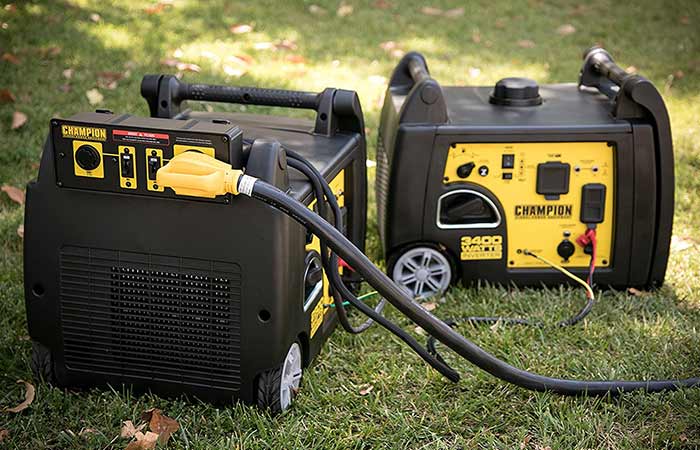When your source of power is prone to interruptions or you need power where isn’t any (such as the woods or other remote locations), you’ll need a generator for that. However, a single generator may not be enough in some cases. This can either be that it’s too small to supply the needed power, or that it’s not reliable enough to supply power on a consistent basis.
This calls for the use of more than one generator to support the same load. The process is called generator paralleling and it requires some technical abilities to do so. This is because it’s not as simple as combining the power output lines from different generators together as this won’t work.
To use generators in parallel, you need a parallel kit. You also need to know that only generators with matching outputs should be connected in parallel. However, there is a way you can connect generators of different sizes and brands in parallel as shall be shown below.
What is Generator Paralleling?
Paralleling is the synchronization or combination of two or more electrical inputs through matching the output voltage waveform of one electrical system with that of another system. Simply put, generator paralleling is the connection of two or more generators on a parallel circuit to provide more power than each individual generator.
With proper paralleling, you can have double the power of the individual generators. This helps support a larger load than before. The primary benefit of generator paralleling, however, is that it eliminates the points of failure in that one generator or connection failing doesn’t kill the whole power supply system.
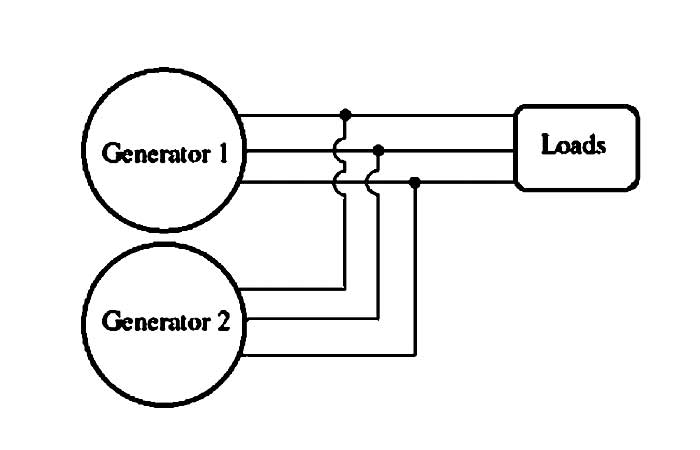
How to Parallel Generators
You need a generator parallel kit for this exercise. With the kit, you only need to connect the generators to it then the kit will supply the power to the load. The important aspects about this process are as follows:
Frequency
The frequency of the power input (the generators) must be matched to each other. The frequency difference needs to be less than 0.2 Hz for the best result.
Phase rotation
The phase rotation should also be matched between the generators.
Phase voltages
The phase voltages have to be in phase and within the voltage range specified.
- Voltage amplitude difference
- Waveform
These aspects are taken care of by the parallel kit although the inputs matter a lot to the workings of the circuit. You’ll still need to have the proper generator brands and size before you use them in a parallel connection with one another.
Factors to consider when paralleling generators
For the best experience paralleling generators, consider the aspects below:
1. Capacity
You need to know your power needs and how to meet them through generator paralleling. For example, you need to focus on the amount of the load or expected load and how the addition of an extra generator(s) will meet that. Keep in mind that you can’t predict the exact amount of the load when adding or subtracting items from the load. However, you should have a clear picture of it.
2. Compliance
The electrical circuit you set up needs to be compliant with all the electrical standards of your area in terms of the operations, safety and protection or property and lives. In the case of an accident, you can be sure that the law will be on your side.
3. Redundancy
The aim is to avoid cases where there are periods without power when switching on or off one of the generators. The process should be seamless such that you can add and subtract a generator from the circuit without causing a disturbance to the whole connection.
4. Load balance
When connecting the generators in parallel, the entire load ought to the shared among them as per their individual capacities. This means that each generator should have the same load output percentage to avoid overloading some while underutilizing the others.
5. Voltage regulation
The amount of output needs to be regulated to avoid frying the electrical appliances connected to the generators. The most obvious result of this connection is that the power output will go up. If not regulated, it’ll overload the circuit leading to damage on the appliances.
6. Speed control
While the generators can have different engine speeds, they must match the final speed of the system to use them. This does away with the fluctuations in power that can occur due to the uneven speeds.
7. Synchronization
The power output from a parallel connection can only be used by appliances when its stable. The way to stabilize them is by syncing the speeds and outputs of the engines such that the phase, frequency and voltages of the units are all compatible with the load.
Why Parallel Generators? Pros & Cons
The pros and cons of paralleling generators are as follows:
Pros
- More power than the individual generators would supply.
- Increased reliability since you’ll have more power supplied by independently connected generators.
- Flexibility in load management.
- Little to no disruption in power as the generators power the circuit independently.
- Low costs of maintenance compared to one large generator as the units can be serviced at different times while power is being supplied by the other generators.
- Reduced light loading of the prime mover generator. With parallel connections, the primary generator will operate efficiently at between 75% and 100% rather than below that where it will likely cause wet stacking.
- Saves money on the generator size. In general, using smaller generators for paralleling is cheaper than buying one large generator to produce the same power as it offers flexible in buying without incurring one major cost at once.
Cons
- Can be costly buying many generators.
- Not all generators are parallel compatible.
- Can be complex estimating the power output of generators especially when there not of the same size.
Compatible Generators
The best way to connect generators in parallel is when they have the same output frequency, voltage and alternator pitch. Compatible generators are those that have compatible alternators, engines, load sharing controls, speeds, monitoring systems and interfaces to the controls. This is only possible with generators from the same or related manufacturers.
Incompatible Generators
If generators aren’t compatible, it becomes difficult to connect them in parallel to power the same load. Even when generators might be of the same size and brand, they might still not be parallel compatible due to many different issues.
Similarly-sized generators can support a load without issues. However, those with different outputs will be limited by the output of the smaller generator. This is because when the load increases, the smaller generator will be overloaded unless it’s switched off or prevented from trying to match the larger load.
Trying to prevent the smaller generator from stepping up can be quite complex as the process can introduce more failure points on the circuit. For the best design of a such a circuit, make sure that the larger loads are dropped first in the case the bigger generator fails. This only leaves the smaller loads for the smaller generators.
Always use generators with the same load rating, paralleling controls and the same manufacturer for the best results. If it’s not possible, use a special parallel kit to enable that. Inbuilt paralleling controls in modern generators eliminate the need for external paralleling kits for most users.
Can you parallel two different size generators?
Yes. Although most parallel circuits with generators of the same size and brand, there are parallel kits which can be used to connect generators of different brands, sizes and other aspects. Such kits can also be used to connect in parallel generators that aren’t even parallel compatible.
One such kit is the Smart Generator Paralleling Panel by Power Temp Systems. This unit is available from 400 Amp to 4000 Amp and comes with a web-based monitoring system. This means that you can monitor its workings on your phone or computer. It’s one of the most flexible units as it allows for the addition and subtraction of generators from the parallel connection much easier than other kits do.
Generator Parallel Kits
Generator parallel kits help overcome the manual process of connecting generators in parallel. You simply plug in the output cables of the generators then the output from the parallel kit goes to serve the load and that’s it.
Some of the best kits for paralleling generators include the following:
1. Champion 50-Amp RV Ready Parallel Kit
This parallel kit is made for the RV user who needs more than 2800 watts of power. It’s an easy-to-use fixture that can link up two Champion generators to generate large amounts of power when you need it. The good features about this parallel kit include the following:
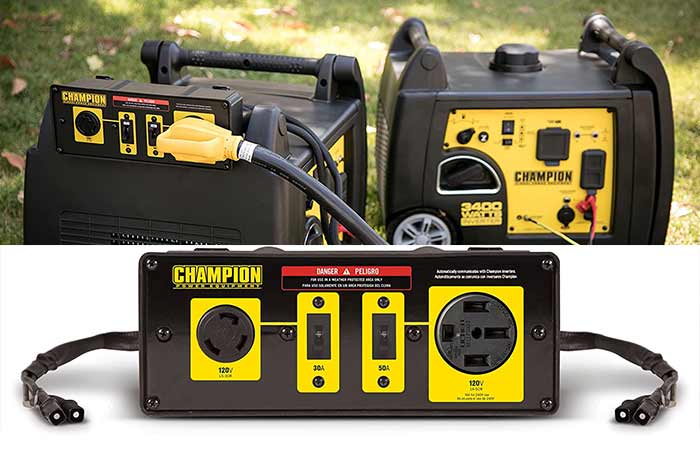
- Toolless installation requiring no tools to integrate generators.
- RV ready as it’s equipped with the standard 50A RV outlet.
- Enables increase of power to amounts that can run two 15,000BTU RV air conditioners.
- Includes additional outlets including 120V 30A and 120V 50A RV (14-50R) locking outlets.
- Has 30 Amp and 50 Amp circuit breakers which prevent overloading.
- 1-year limited warranty.
This parallel kit is a great choice if you have Champion generators and want to link a few of them for more power.
2. Westinghouse Inverter Generator Parallel Cord
For those who use Westinghouse generators, this is the best bet when it comes to connecting Westinghouse generators in parallel. The best things about it are as follows:
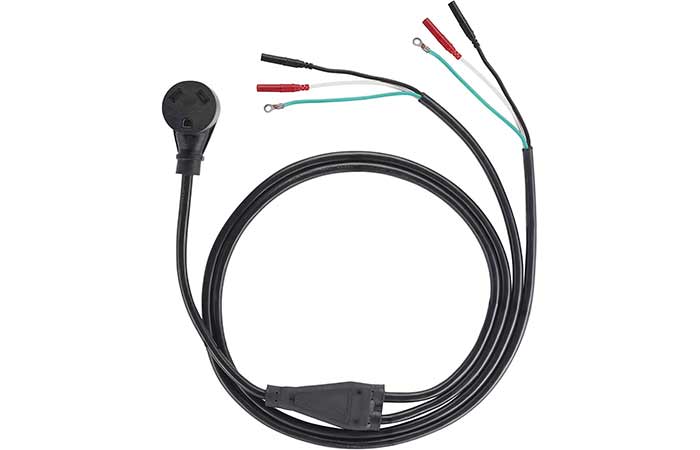
- A simple setup not requiring any complicated ground terminal wiring or junction box.
- Illuminated plugs and switches for ease of visibility in the dark as well as during the day.
- Highly durable rubber-molded receptacles.
- 3 receptacles namely two 120VAC NEMA 5-20R Household Power Outlets and one NEMA TT-30 Recreational Vehicles (RV) style power outlets.
- Compatible with WEN generators of the following series iGEN2500, iGen2200, iGen1200, WH2400i, WH2200iXLT and WH2000iXLT.
This has one of the easiest setups of any parallel kit.
3. Generac 6877 Parallel Kit for iQ2000 Portable Inverter Generator
Generac’s entry into the paralleling fray is in the form of the minimalist 6877 Parallel Kit which has the following impressive features:
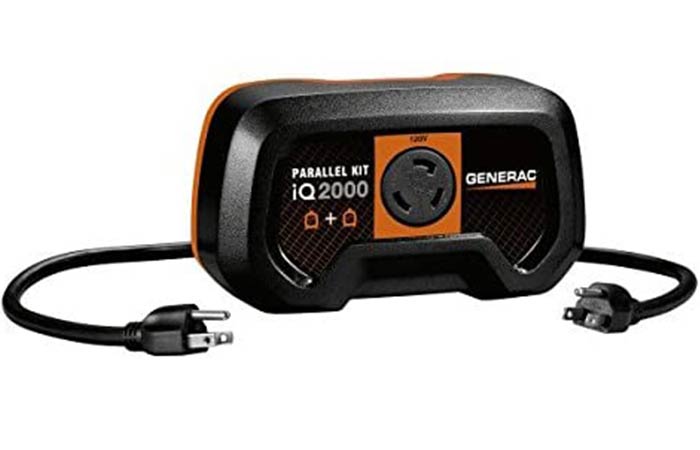
- Enables connections of power up to 4,000 and 3,200 starting and running wattages respectively.
- Connects directly to the RV or generator cord with an L5 30 Amp receptacle.
- No separate parallel jacks required as it connects directly to the 120V outlets of your generator.
The only downside to this parallel kit is that it’s only meant to work with Generac iQ2000 portable inverter generators. otherwise, it’s a great unit.
4. WEN 56421 30 Amp Parallel Connection Kit for Inverter Generators
For WEN generators up to 30 Amps and 3600 watts, the WEN 56421 parallel connection kit is the solution to bump up your power while connecting WEN generators in parallel. Its features include the following:
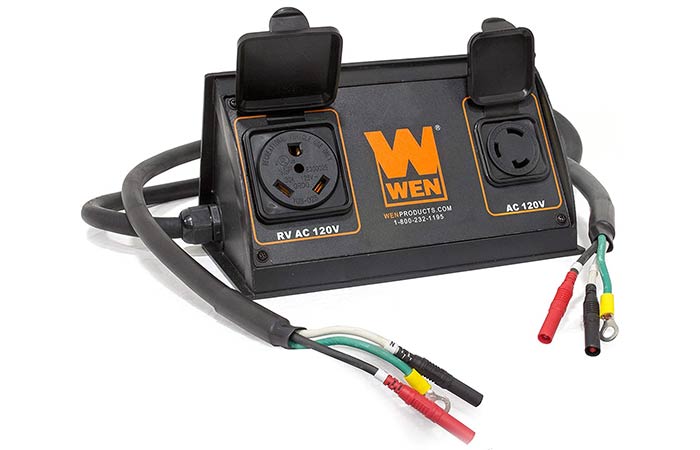
- Connects two WEN generators up to 30 Amps and 3600 watts or output.
- Easy to mount unto the generators.
- Includes an RV-ready 120V outlet (TT-30) and a twist-lock 120V outlet (L5-30).
- Long 7-foot reach.
- 1 year warranty.
This is the best solution for paralleling WEN generators although we wish it could be compatible with more models.
5. Pulsar Products PG-iPAIR-B1 Inverter Kit Adapter, Parallel Adaptor
Pulsar generators in need of paralleling can make use of this unit which has the following great features:

- Comes with a 120V RV TT-30R 30A and 120V L5-30R 30A twist-lock outlets
- 1 year warranty.
Besides these parallel kits, you can still have others from manufacturers such as Firman, Briggs & Stratton, Honda and others. Still, you can have a smart parallel kit to connect generators from different manufacturers and at different sizes.
